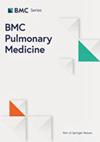Impact of head-of-bed elevation angle on the development of pressure ulcers and pneumonia in patients on mechanical ventilation: a systematic review and meta-analysis
IF 2.6
3区 医学
Q2 RESPIRATORY SYSTEM
引用次数: 0
Abstract
Mechanical ventilation is crucial for patient management in intensive care units, but it comes with complications such as pressure ulcers and ventilator-associated pneumonia (VAP). The impact of head-of-bed elevation angles on these complications remains a critical area for investigation. This systematic review and meta-analysis followed PRISMA guidelines and involved searches across PubMed, Embase, Web of Science, and Cochrane Library, conducted on September 19, 2023, with no date or language restrictions. We included randomized controlled trials that compared different head-of-bed elevation angles in adult ICU patients on mechanical ventilation. Data were extracted on study characteristics, quality assessed using the Cochrane risk of bias tool, and statistical analyses performed using chi-square tests for heterogeneity and fixed or random-effects models based on heterogeneity results. Six studies met inclusion criteria out of an initial 601 articles. These studies showed minimal heterogeneity (I2 = 0.0% for pressure ulcers, p = 0.930; and for VAP, p = 0.797), supporting the use of fixed-effect models. Results indicated that a higher elevation angle (45°) significantly increased the risk of pressure ulcers (OR = 1.95, 95% CI: 1.12–3.37, p < 0.05) and decreased the incidence of VAP compared to a lower angle (30°) (OR = 0.51, 95% CI: 0.31–0.84, p < 0.05). While higher head-of-bed elevation can reduce the risk of VAP in mechanically ventilated patients, it may increase the risk of pressure ulcers. Clinical strategies should carefully balance these outcomes to optimize patient care in ICU settings. PROSPERO 2024 CRD42024570232.床头抬高角度对机械通气患者压疮和肺炎发生的影响:系统回顾和荟萃分析
机械通气对重症监护病房的患者管理至关重要,但也会带来压疮和呼吸机相关肺炎(VAP)等并发症。床头抬高角度对这些并发症的影响仍是一个重要的研究领域。本系统综述和荟萃分析遵循 PRISMA 指南,于 2023 年 9 月 19 日在 PubMed、Embase、Web of Science 和 Cochrane 图书馆进行了检索,没有日期或语言限制。我们纳入了对接受机械通气的 ICU 成人患者床头抬高角度进行比较的随机对照试验。我们提取了有关研究特征的数据,使用 Cochrane 偏倚风险工具评估了研究质量,并根据异质性结果使用卡方检验和固定或随机效应模型进行了统计分析。在最初的 601 篇文章中,有六项研究符合纳入标准。这些研究显示异质性极小(I2 = 0.0%,压疮,p = 0.930;VAP,p = 0.797),支持使用固定效应模型。结果表明,与较低的角度(30°)相比,较高的仰角(45°)会明显增加压疮的风险(OR = 1.95,95% CI:1.12-3.37,p < 0.05),降低 VAP 的发生率(OR = 0.51,95% CI:0.31-0.84,p < 0.05)。虽然较高的床头抬高角度可以降低机械通气患者发生 VAP 的风险,但可能会增加压疮的风险。临床策略应仔细平衡这些结果,以优化重症监护病房的患者护理。PERROPO 2024 CRD42024570232。
本文章由计算机程序翻译,如有差异,请以英文原文为准。
求助全文
约1分钟内获得全文
求助全文
来源期刊

BMC Pulmonary Medicine
RESPIRATORY SYSTEM-
CiteScore
4.40
自引率
3.20%
发文量
423
审稿时长
6-12 weeks
期刊介绍:
BMC Pulmonary Medicine is an open access, peer-reviewed journal that considers articles on all aspects of the prevention, diagnosis and management of pulmonary and associated disorders, as well as related molecular genetics, pathophysiology, and epidemiology.
 求助内容:
求助内容: 应助结果提醒方式:
应助结果提醒方式:


